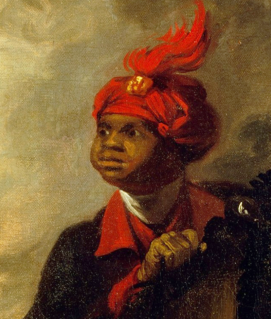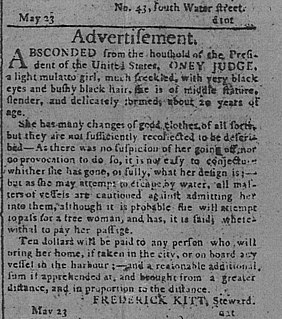
George Washington was an American military officer, statesman, and Founding Father who served as the first president of the United States from 1789 to 1797. Appointed by the Continental Congress as commander of the Continental Army, Washington led the Patriot forces to victory in the American Revolutionary War and served as the president of the Constitutional Convention of 1787, which created the Constitution of the United States and the American federal government. Washington has been called the "Father of his Country" for his manifold leadership in the formative days of the country.

Martha Dandridge Custis Washington was the wife of George Washington, the first president of the United States. Although the title was not coined until after her death, Martha Washington served as the inaugural first lady of the United States. During her lifetime, she was often referred to as "Lady Washington".

James Madison Hemings was the son of the mixed-race enslaved woman Sally Hemings and her enslaver, President Thomas Jefferson. He was the third of her four children to survive to adulthood. Born into slavery, according to partus sequitur ventrem, Hemings grew up on Jefferson's Monticello plantation, where his mother was enslaved. After some light duties as a young boy, Hemings became a carpenter and fine woodwork apprentice at around age 14 and worked in the Joiner's Shop until he was about 21. He learned to play the violin and was able to earn money by growing cabbages. Jefferson died in 1826, after which Sally Hemings was "given her time" by Jefferson's surviving daughter Martha Jefferson Randolph.

William Lee, also known as Billy or Will Lee, was a slave and personal assistant of George Washington. He was the only one of Washington's slaves who was freed immediately by Washington's will. Because he served by Washington's side throughout the American Revolutionary War and was sometimes depicted next to Washington in paintings, Lee was one of the most publicized African-Americans of his time.

The history of George Washington and slavery reflects Washington's changing attitude toward enslavement. The preeminent Founding Father of the United States and a hereditary slaveowner, Washington became increasingly uneasy with it. Slavery was then a longstanding institution dating back over a century in Virginia where he lived; it was also longstanding in other American colonies and in world history. Washington’s will provided for the immediate emancipation of one of his slaves, and additionally required his remaining 123 slaves to serve his wife and be freed no later than her death, so they ultimately became free one year after his death.

Ona "Oney" Judge Staines was a woman of mixed races who was enslaved to the Washington family, first at the family's plantation at Mount Vernon and later, after George Washington became president, at the President's House in Philadelphia, then the nation's capital city. In her early twenties, she absconded, becoming a fugitive slave, after learning that Martha Washington had intended to transfer ownership of her to her granddaughter, known to have a horrible temper. She fled to New Hampshire, where she married, had children, and converted to Christianity. Though she was never freed, the Washington family did not want to risk public backlash in forcing her to return to Virginia and after years of failing to persuade her to return, the family stopped pressing her to go back.
Harry Washington was a Black Loyalist in the American Revolutionary War, and enslaved by Virginia planter George Washington, later the first President of the United States. When the war was lost the British then evacuated him to Nova Scotia. In 1792 he joined nearly 1,200 freedmen for resettlement in Sierra Leone, where they set up a colony of free people of color.
Hercules Posey was an enslaved African owned by George Washington, at his plantation Mount Vernon in Virginia. "Uncle Harkless," as he was called by George Washington Parke Custis, served as chief cook at the Mansion House for many years. In November 1790, Hercules was one of eight enslaved Africans brought by President Washington to Philadelphia, Pennsylvania, then the temporary national capital, to serve in the household of the third presidential mansion.

Christopher Sheels, was an enslaved house servant at George Washington's plantation, Mount Vernon, in Virginia, United States.

David Stuart was a Virginia physician, politician, and correspondent of George Washington. When Washington became President of the United States, he made Stuart one of three commissioners appointed to design a new United States capital city.

William "Billy" Costin was a free African-American activist and scholar who successfully challenged District of Columbia slave codes in the Circuit Court of the District of Columbia.

The Quander family is believed to be the oldest documented African-American family that has come from African ancestry to present day America. Historians believe so because they cannot find any records of any other African-American family whose ancestry has been consistently kept and published.
Lund Washington (1737–1796) was a distant cousin of George Washington who served as steward of the Mount Vernon estate during the American Revolution.

West Ford was the caretaker and manager of Mount Vernon, which had been the home of George Washington. Ford also founded Gum Springs, Virginia near Mount Vernon. He was a man of mixed-race, and possibly of Washington descent.
Betty was a biracial enslaved woman owned by Martha Washington. She was owned by the Custis Estate and worked at Daniel Parke Custis' plantation, the White House, on the Pamunkey River in New Kent County, Virginia. Custis married Martha Dandridge in 1750 and, when he died in 1757, Betty became one of Martha's dower slaves whom she brought to George Washington's plantation, Mount Vernon, after the Washington marriage in 1759. Betty worked at Mount Vernon until she died.
Sarah Johnson was an African American woman who was born into slavery at Mount Vernon, George Washington's estate in Fairfax, Virginia. She worked as a domestic, cleaning and caring for the residence. During the process, she became an informal historian of all of the mansion's furnishings. After the end of the Civil War, she was hired by the Mount Vernon Ladies' Association, ultimately becoming a council member of the organization. She bought four acres of Mount Vernon land to establish a small farm. The book Sarah Johnson's Mount Vernon (2008) tells the story of her life within the complex community of people who inhabited Mount Vernon.

Maria Carter Syphax, otherwise spelled Mariah, was the matriarch of the Syphax family, a prominent family of African Americans in the greater Washington, D.C. area who became civic leaders, civil servants, and educators. She was born into slavery as Maria Carter, daughter of an enslaved woman and George Washington Parke Custis, a grandson of Martha Washington through her first marriage. Syphax was thus a great-granddaughter of First Lady Martha Washington.

Caroline Branham (1764–1843) was an enslaved housemaid and seamstress of George and Martha Washington. She was married to Washington's hired groomsman Peter Hardiman, whose slaveholder was David Stuart. Branham gave birth to nine children, eight with Hardiman. Her ninth child, Lucy, is believed to have been a child of the plantation; the girl's father was George Washington Parke Custis. Branham served the Washington family and their many visitors, ensuring that they resided in comfort.

William Syphax was born into slavery but manumitted when he was about one year old, along with his mother Maria Carter Syphax and sister. As a young man, he became a U.S. government civil servant in Republican administrations, and built a network in the capital city.














